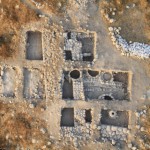Hebron—one of the first places Abraham arrived after God called him to be a father of many nations—is the site of an important dig as the Israel Antiquities Authority (IAA) searches for the answers to Israel’s ancient past, particularly the remnants of King David’s 3,000-year-old palace.

Sheep grazing in Jerusalem: Although David was a shepherd from Bethlehem, which is about six miles (nine km) south of Jerusalem, God called him through the prophet Samuel to be the king of Israel. He first ruled from Hebron, but then established the capital in Jerusalem.
The City of David, which is on a narrow ridge running south of the Temple Mount in Jerusalem, is where King David reigned over all Judah and Israel, but he also reigned from Hebron for seven years:
“David was thirty years old when he became king, and he reigned forty years. In Hebron he reigned over Judah seven years and six months, and in Jerusalem he reigned over all Israel and Judah thirty-three years.” (2 Samuel 5:4–5)
He may have chosen Hebron as the site for a palatial residence since it is where he was anointed to become Israel’s second king:
“Then the men of Judah came to Hebron, and there they anointed David king over the tribe of Judah.” (2 Samuel 2:4)

A Jewish child at Hebron’s Cave of the Patriarchs, where Abraham, Isaac, Jacob, Sarah, Rebecca and Leah are buried.
The site of the Hebron dig is known today as the Jewish neighborhood of Tel Rumeida, which is believed to be the Biblical location of Hebron.
This site is a logical place to dig for David’s palace since it is one of the higher elevations in the area. It is reasonable to assume that a king would build his palace in such a location.
This site has already shown promise. In the mid 1960s, excavations revealed portions of a wall dating to the time of Abraham and artifacts from the Biblical period.
Although the IAA dig is on land owned by Jewish people, it is located in the disputed territory of Judea and Samaria, also known as the West Bank.
Hebron, which is holy to both Jews and Muslims, has been the site of frequent clashes between Jews and Palestinians. Some high-profile land disputes here are still before the Israeli Supreme Court.
The dig, therefore, has been criticized by some, including Yariv Oppenheimer, the director of Peace Now, an organization that works to stop all Israeli settlement activity: “This is settlement expansion under the guise of archaeology … enabling the settlers to expand and change the status quo in the most sensitive part of the West Bank.”

A Palestinian girl in Hebron holds a protest sign that says, “Surely we will return, Palestine” on Nakba Day (Day of the Catastrophe), which marks the day Israel declared her Independence on May 15, 1948.
Opponents of Jewish settlements in the land where David reigned not only want to see Jewish homes dismantled, they fear that if evidence of King David’s palace is found to have existed in Hebron, the whole Palestinian claim that Jews never lived here will crumble. (Jewsdownunder)
In spite of claims that the land is Palestinian, the historical evidence from the Bible, archaeological discoveries, and an almost continuous Jewish presence here already proves these claims false.
Hebron is the site of the oldest Jewish community in the world. This is where Abraham is buried, along with the other patriarchs and all but one matriarch of the Jewish People.
Places other than the Tel Rumeida site are also considered strong candidates for the location of David’s Hebron castle. For instance, the remnants of a Biblical era palace may have been discovered in the area.
A pillar and its attached capital show clear evidence of a royal structure that is believed to be buried in this undisclosed location.
“We appear to have a complete castle here,” Kfar Etzion Field School Director Yaron Rosental said. “Those who lived here after it did not know of its existence and thus, instead of using its stones to build a new building as was the usual practice, left it intact.” (Israel Today)
Although the school recently said that it would publicly reveal the true location of David’s castle on Friday January 17th, as of the time of this writing no revelation has been made.
The fact that the location lies on land claimed by the Palestinian Authority may explain why this information has not yet been forthcoming. Such a revelation would likely ignite a storm of controversy.

During the 1929 Hebron massacre, 67 Jews were killed by Arab rioters. Many others were raped, mutilated, and tortured. In 1931, the British decided to prevent another massacre by moving all Jews out of Hebron. Egypt occupied Hebron in early 1948, but later that year Jordan took control. Hebron came under Israeli control after the 1967 Six Day War.
There are many ancient treasures buried throughout Israel and many of them will be found on land held by the Palestinians.
It is unlikely that such finds would ever be announced, since they would seriously undermine the Palestinian claim that Palestine has always been Arab territory.
Still, no independent Arab or Palestinian state ever existed in the Holy Land. Conversely, the Jewish people have been here in their historic homeland for more than 3,700 years, despite being conquered and exiled several times.
For almost 4,000 years, the Jewish People have lived in the same land where God planted them. This fact alone is reason to rejoice as it testifies to the eternal nature of God’s covenant with His people.
“He confirmed it to Jacob as a decree, to Israel as an everlasting covenant: ‘To you I will give the land of Canaan as the portion you will inherit.’” (1 Chronicles 16:17–18)
The continued existence of the Jewish People in the Holy Land is clear indication of the truth of the Word of God. All of God’s promises will be fulfilled! What’s more, His faithfulness to Israel testifies of His love for us!












